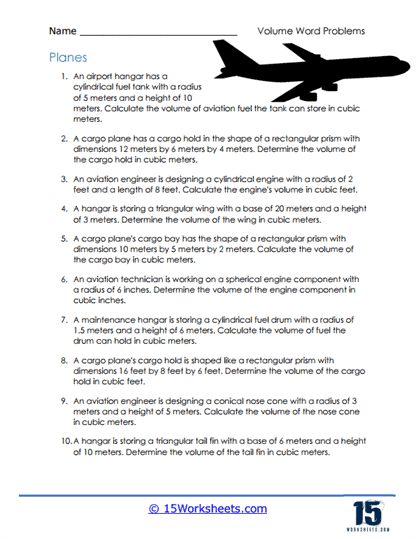Planes

Worksheet Description
This worksheet is composed of word problems that deal with calculating the volume of various components related to airplanes and aviation. It presents objects such as a cylindrical fuel tank in an airport hangar, a cargo plane’s cargo hold, and a spherical engine component, each with given dimensions. Students are prompted to determine the volume of these objects using the appropriate geometric formulas. The problems vary in complexity and involve different shapes, including cylinders, rectangular prisms, and cones.
The objective of this worksheet is to teach students how to apply volume formulas for different geometric shapes in the context of aviation-related scenarios. It reinforces the students’ ability to recognize geometric shapes and associate them with their respective volume calculations. The worksheet also aims to strengthen problem-solving skills by having students interpret word problems and convert real-world situations into mathematical calculations. Moreover, it introduces students to the practical applications of geometry in technology and engineering fields, such as aerospace.
Example Problems
1. An airport hangar has a cylindrical fuel tank with a radius of 5 meters and a height of 10 meters. Calculate the volume of aviation fuel the tank can store in cubic meters.
2. A cargo plane has a cargo hold in the shape of a rectangular prism with dimensions 12 meters by 6 meters by 4 meters. Determine the volume of the cargo hold in cubic meters.
3. An aviation engineer is designing a cylindrical engine with a radius of 2 feet and a length of 8 feet. Calculate the engine’s volume in cubic feet.
4. A hangar is storing a triangular wing with a base of 20 meters and a height of 3 meters. Determine the volume of the wing in cubic meters.
5. A cargo plane’s cargo bay has the shape of a rectangular prism with dimensions 10 meters by 5 meters by 2 meters. Calculate the volume of the cargo bay in cubic meters.
6. An aviation technician is working on a spherical engine component with a radius of 6 inches. Determine the volume of the engine component in cubic inches.
7. A maintenance hangar is storing a cylindrical fuel drum with a radius of 1.5 meters and a height of 6 meters. Calculate the volume of fuel the drum can hold in cubic meters.
